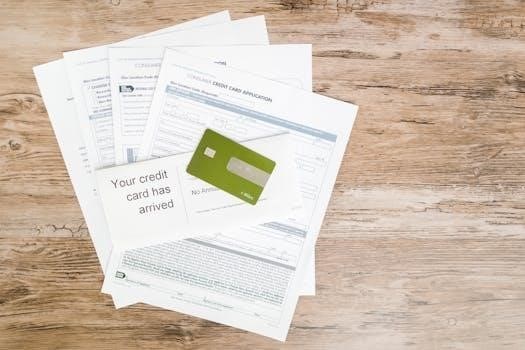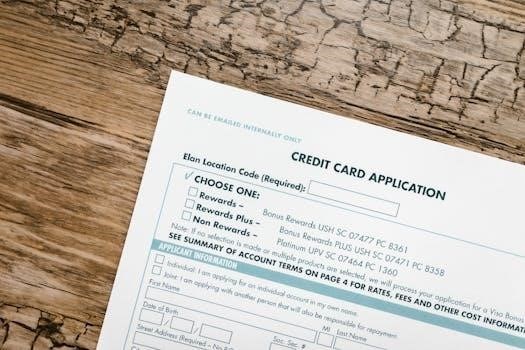The Ontario Standard Lease is a crucial document for rental agreements, ensuring clarity between landlords and tenants․ It is a mandatory contract for most private residential tenancies, creating a legally binding framework․
Purpose of the Standard Lease Form
The primary purpose of the Ontario Standard Lease is to standardize rental agreements, providing a clear and consistent framework for both landlords and tenants․ This helps avoid ambiguity and disputes by outlining the terms and conditions of the tenancy in a structured manner․ This mandatory form ensures that all parties are aware of their rights and responsibilities under the Residential Tenancies Act, promoting fairness and transparency in the rental process․ The lease aims to simplify the process of rental agreements․

Mandatory Use of the Standard Lease
The Ontario Standard Lease is mandatory for most private residential rental agreements made on or after April 30, 2018․ Landlords must use this official form to ensure legal compliance․
Applicability of the Standard Lease
The Standard Lease applies to most residential tenancies in Ontario․ This includes various types of properties, such as single and semi-detached houses, apartments, condominiums, and basement units․ It is essential for landlords to use this lease when entering into a new agreement, ensuring it complies with the Residential Tenancies Act․
When the Standard Lease is Required
The Ontario Standard Lease is mandatory for most new residential tenancy agreements signed on or after April 30, 2018․ Landlords must use this form when establishing a tenancy with a tenant․ This requirement ensures consistency and legal compliance in rental agreements, promoting a fair and standardized process for all parties involved․
Key Components of the Standard Lease
The standard lease includes essential terms and conditions, outlining the rights and responsibilities of both landlords and tenants․ It ensures a comprehensive agreement for residential tenancies in Ontario․
Essential Terms and Conditions
The Ontario Standard Lease meticulously outlines crucial details such as the rental amount, payment due dates, and the duration of the tenancy․ It also specifies rules regarding services, utilities, and deposits․ These mandatory terms ensure that both landlords and tenants have a clear understanding of their obligations and rights within the agreement, providing a foundation for a fair and transparent rental relationship․ It also addresses important aspects such as insurance and smoking policies․
Additional Terms and Agreements
While the standard lease covers essential elements, landlords and tenants can include supplementary terms and agreements as separate addendums․ However, these additions must not contradict the Residential Tenancies Act, 2006․ Tenants are not obligated to agree to extra terms, and any modifications made after signing are invalid․ These additional agreements often address specific clauses or unique property conditions, ensuring both parties are aligned on all aspects of the tenancy beyond the standard framework․

Rights and Responsibilities
The Ontario Standard Lease clearly outlines the obligations of both landlords and tenants․ It details the services provided by the landlord and the duties expected of tenants․
Landlord Obligations
Landlords in Ontario have specific duties under the Standard Lease․ They must provide a habitable dwelling, maintain the property, and ensure all services outlined in the agreement are functional․ Landlords are also required to give proper notice for entry and adhere to fair practices, avoiding discrimination and harassment․ Additionally, they must provide rent receipts to the tenant and are bound by the Residential Tenancies Act․
Tenant Responsibilities
Tenants in Ontario also have specific responsibilities under the Standard Lease․ They must pay rent on time, maintain reasonable cleanliness, and avoid causing damage to the property․ Tenants are also expected to respect the rights of other tenants and neighbors, follow building rules, and report maintenance issues promptly․ Furthermore, they are required to use the premises for residential purposes only and adhere to the terms of the lease․
Changes and Updates
The Ontario Standard Lease has seen revisions over time․ It’s crucial to use the most recent version, with updates effective from March 1, 2021, for new tenancies․
Versions of the Standard Lease
There have been different versions of the Ontario Standard Lease․ It’s essential to distinguish between the older and updated forms․ Until February 28, 2021, either the old or new version could be used, but after that date, the updated one is mandatory for new tenancy agreements․ The current, updated version must be utilized for all new agreements․
Recent Amendments and Effective Dates
The Ontario Standard Lease underwent amendments, with the updated version becoming mandatory for tenancy agreements entered into on or after March 1, 2021․ Landlords and tenants should ensure they are using the most current version of the form․ Changes and updates to the standard lease reflect ongoing efforts to improve clarity and fairness in rental agreements․
Where to Obtain the Standard Lease
The official Ontario Standard Lease can be accessed through the government’s website․ This ensures users obtain the correct, legally compliant document for their rental agreements․
Official Government Website
The primary and most reliable source for obtaining the Ontario Standard Lease is the official website of the Government of Ontario․ This ensures you are using the most current and legally valid version of the form․ Downloading directly from the government site guarantees that the document complies with all current regulations and legislation, providing peace of mind for both landlords and tenants․
Alternative Sources for the Form
While the official government website is the recommended source, the Ontario Standard Lease might also be found on other reputable platforms․ These can include legal websites, real estate associations, and some property management service sites․ However, it is important to exercise caution and verify that any alternative source provides the most recent version of the form to avoid using outdated or non-compliant documents․

Consequences of Not Using the Standard Lease
Failure to use the standard lease can lead to invalid agreements and legal issues for landlords․ Non-compliance could affect the enforceability of the tenancy terms․
Validity of Agreements
Using a non-standard lease form may jeopardize the validity of the entire rental agreement․ Agreements not adhering to the prescribed format might not be legally binding, potentially causing disputes and legal challenges for both landlords and tenants․ The Ontario Standard Lease is designed to protect both parties, ensuring that all terms are clear and compliant with the Residential Tenancies Act, 2006․
Legal Ramifications
Failure to use the Ontario Standard Lease can lead to significant legal ramifications for landlords․ They may face penalties, fines, and legal challenges from tenants who are aware of their rights․ Furthermore, agreements that do not comply with the Residential Tenancies Act might be deemed unenforceable, leaving landlords vulnerable to potential losses and disputes․ Landlords must use the standard form to avoid these issues․
Who Completes the Standard Lease
The landlord is primarily responsible for completing the Ontario Standard Lease․ Both the landlord and the tenant must sign the agreement for it to be valid and legally binding․
Responsibilities of Landlords
Landlords are obligated to use the standard lease form for most residential tenancies in Ontario․ They must accurately complete all sections of the lease, including all required information like names, addresses, and rent details․ Furthermore, they are responsible for providing a copy of the signed lease to the tenant before the tenancy begins and ensuring the lease adheres to the Residential Tenancies Act․
Role of Tenants
Tenants are responsible for carefully reviewing the entire standard lease agreement before signing․ It’s important to understand all terms and conditions, including payment obligations, lease duration, and any additional rules․ They have the right to receive a complete and accurate copy of the lease from the landlord․ Tenants should also ensure they understand the rights and responsibilities outlined within the Residential Tenancies Act․
Lease Duration
Lease terms in Ontario can vary, and while there’s no maximum or minimum length, the agreement must specify the duration․ It could range from weeks to years, based on mutual agreement․
Legality of Different Lease Terms
In Ontario, lease agreements can be for any duration as long as both the landlord and tenant mutually agree to the terms․ There is no legal restriction on the length, allowing for flexible arrangements․ This can range from short-term to long-term agreements, provided they are clearly stated and agreed upon in the lease document․ However, all agreements must adhere to the Residential Tenancies Act․
Minimum and Maximum Lease Periods
Ontario law does not stipulate a minimum or maximum period for lease agreements․ This means that a lease can be for any length of time, whether it’s a week, several months, or even multiple years, as long as both parties agree․ The important aspect is that the agreed-upon duration is clearly documented in the lease, ensuring a mutual understanding and avoiding any future disputes regarding the term of the tenancy․

Rent and Payment Details
Landlords must provide rent receipts to tenants․ Ontario has annual rent increase guidelines, usually published in August․ These guidelines dictate the permissible percentage for rent increases․
Rent Receipts
In Ontario, landlords have a legal obligation to provide tenants with rent receipts․ These receipts serve as proof of payment and are important for both parties․ Tenants may require these for various purposes, such as tax filing or accessing housing assistance programs․ Landlords must issue receipts promptly upon receiving rent payments; These receipts should clearly state the amount paid, the date received, and the property address․
Rent Increase Guidelines
Ontario has specific guidelines regulating how much and how often landlords can increase rent․ These rules are set annually by the province and are often published in August․ Landlords must adhere to these guidelines; typically a percentage increase is allowed․ Notice must be provided to tenants in writing at least 90 days before any rent increase takes effect; Rent increases are capped to prevent excessive charges on tenants․
Special Cases and Exceptions
The standard lease has exemptions for certain types of accommodations, such as care homes and mobile home parks․ These situations may have specific regulations, differing from standard rental agreements․
Exemptions from the Standard Lease
While the Ontario Standard Lease is mandatory for most residential rentals, there are specific exemptions․ These include care homes, sites in mobile home parks, and member units in co-operative housing․ Additionally, accommodations that are exempt under section five of the Residential Tenancies Act, 2006, are not required to use the standard lease․ Understanding these exemptions is vital for landlords and tenants․
Specific Situations and Regulations
Certain situations and regulations can affect the application of the Ontario Standard Lease․ For instance, a new landlord inherits the rights and duties of the previous one․ Also, the Residential Tenancies Act, 2006, governs rental housing in Ontario, and the lease cannot take away any rights or responsibilities under this act․ Understanding these specifics is crucial for compliance․



